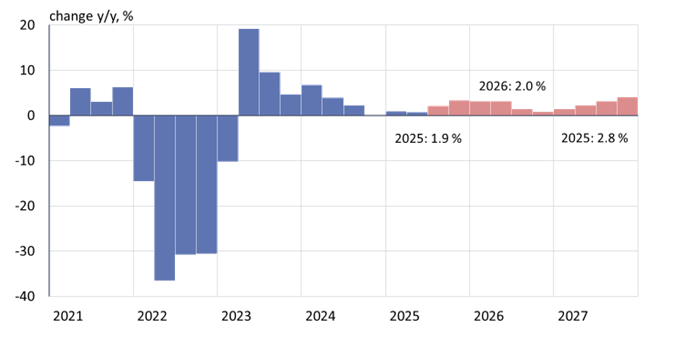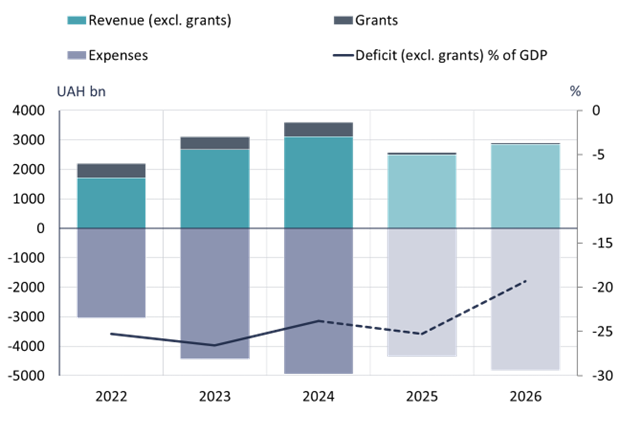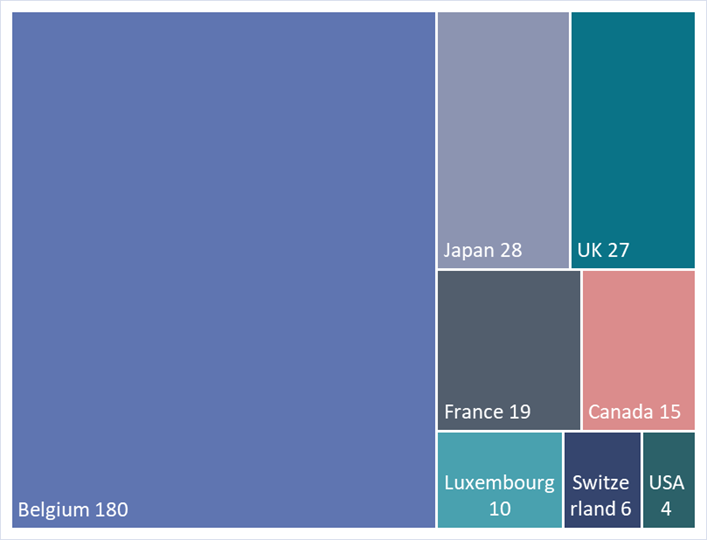BOFIT Weekly Review 47/2025
Ukraine’s economy slows and fiscal deficit rises
Shelling on Ukraine’s energy sector and belated harvest reduced first-half growth
Ukraine’s on-year GDP growth fell below 1 % in the first six months of this year. Russian bombing of gas production & distribution infrastructure, labour shortages and a weak spring harvest dragged down economic growth. Agricultural output shrank by 23 % y-o-y in the second quarter due to the belated harvest. The prognosis for the entire year’s harvest, however, is still relatively good – and harvests of certain crops are on track to be at par or larger than last year.
Industrial output contracted by 3.9 % in the first half of 2025, mainly due to the weak performance of extractive industries. With the evacuations of Ukraine’s important domestic energy production areas (for example, Pokrovsk), the loss of natural gas production caused extractive industry production overall to fall by over 10 % y-o-y in April and May. With the indoor heating season starting, Russia has stepped up the intensity of its bombing of Ukraine’s energy infrastructure. The October 3 bombings of Kharkiv and Poltava alone took out about 60 % of domestic natural gas production capacity. Scheduled power outages have been implemented on a wide scale across the country.
Conditions in the construction sector improved slightly, particularly for defence-related fortification projects. Manufacturing got a boost from the defence industry and the branches that support it. Consumer-driven branches such as retail sales continued to experience robust growth in the second quarter of this year. Although growth in real wages slowed relative to the first half of the year, they were still up by nearly 6 % y-o-y.
Ukraine’s GDP growth was quite modest in the first half of 2025

Note: 3Q25-4Q27 projections based on NBU forecast.
Sources: Ukrstat, National Bank of Ukraine.
2025 growth forecasts lowered; uncertainty clouds 2026 outlook
Ukraine’s economic growth is expected to slow this year to a range of 1.6–2.5 %. Both international organizations and Ukrainian officials have lowered their forecasts as the year has progressed. The most pessimistic outlook is the 1.6 % growth forecast offered by the European Commission this month, which noted that its downward forecast revision reflected the realized weak growth and destruction of Ukraine’s energy infrastructure.
Looking ahead to 2026, forecasting institutions are more divided. The National Bank of Ukraine (NBU) and the European Commission do not expect an acceleration in growth next year, but instead see growth holding at its 2025 pace. The 2026 forecasts of international institutions are more upbeat. The IMF’s World Economic Outlook update in October sees Ukraine GDP growing by 4.5 % next year. In its forecast released in September, the European Bank for Reconstruction and Development (EBRD) estimated that growth would accelerate next year to 5 % if the fighting ends and reconstruction efforts get under way.
Larger deficit in Ukraine’s government finances this year; fourth wartime budget submitted to parliament
Ukraine was forced in June to revise upward its 2025 budget on higher-than-expected defence costs, war destruction and lower economic growth. Defence spending rises by nearly $10 billion in the revised budget, with most of the spending covered by increased domestic borrowing and higher tax revenues. Taking these adjustments and lower growth into account, the NBU estimates that Ukraine’s public sector deficit will rise this year to over 25 % of GDP, well above the 19 % of GDP projected in the original 2025 budget.
Ukraine’s parliament (Verkhovna Rada) is currently debating the 2026 budget bill. Under the current draft budget, public sector spending rises by 12 % next year to 4.8 trillion hryvnia ($107 billion with an average USD-UAH rate of 45 hryvnia to the dollar). Defence spending will remain roughly at this year’s level (2.8 trillion hryvnia). Increases are planned for other expenditures such as healthcare and teachers' salaries. According to the draft budget, public revenues are expected to rise by 15 % next year to around 2.9 trillion hryvnia ($63 billion). While all tax revenue streams are expected to increase, the biggest revenue boost is expected to come from banks and firms subject to the corporation tax, which was doubled to 50 %.
The draft budget calls for a public sector deficit next year of roughly 1.9 trillion hryvnia ($42 billion) or 19 % of GDP. According to Ukraine’s finance ministry, next year’s yet-to-be-filled financing gap is about $18 billion. The largest sources of next year, similar to 2025, are the G7’s Extraordinary Revenue Acceleration (ERA) lending programme, which is funded from the proceeds from Russian central bank assets held in G7 countries, as well as the EU’s Ukraine Facility.
As of the start of November, Ukraine had received $153 billion in direct budget support since Russia’s 2022 invasion, of which $37 billion in support had been provided this year. Ukraine has also issued $12 billion in state bonds to finance its budget shortfall.
Ukraine’s budget deficit is expected to increase this year

Sources: CEIC, Ukraine’s finance ministry, National Bank of Ukraine.
Major decisions on Ukraine support expected in coming months
Ukraine’s most important new potential financing source is the EU’s proposed plan to provide a “reparations loan” based on income from the frozen assets of the Central Bank of Russia (CBR) held in several countries in Europe and Japan. The initial plan proposed by the European Commission would have used the frozen liquid assets of the CBR under management by the Belgium-based Euroclear financial services group. Of those assets, 140 billion euros would be lent to Ukraine at zero interest. Ukraine would only have to pay back the loan after the war has ended and Russia pays reparations for the damage it has caused to Ukraine. At that point, the European Commission would return the money to Euroclear and Russia’s access to its funds restored. Thus, the funds would not technically be confiscated. Belgium’s opposition to the plan, however, caused it to collapse in October. EU members will revisit the subject of a possible war reparations loan or other financing arrangements in December.
Ukraine’s government has also engaged in formal talks with the IMF on a new Extended Fund Facility (EFF). With the prolonging of Russia’s war of aggression, the assumptions about Ukraine’s financing needs from the previous EFF have become obsolete and the current EFF ends in March 2027. To date Ukraine has received $10.6 billion through the IMF’s EFF programme, or about two-thirds of the total $15.6 billion EFF funds scheduled to be paid out over 48 months.
In September, an IMF delegation arrived in Kyiv to discuss economic and fiscal policy outside the auditing processes required for EFF releases. As part of the discussion, Ukraine’s finance minister estimated that Ukraine’s financing needs for 2026–2029 would amount to $150–170 billion, but no final figure has been officially set. According to the IMF, Ukraine’s supplemental financing needs for the government budget (above and beyond current funding commitments) for 2026–2027 would be $65 billion. The loan amount under the new EFF would only amount to about $8 billion, an amount within the scope of existing guarantees. Roksolana Pidlasa, budget committee chairman of the Verkhovna Rada said that the decisions on the new IMF lending facility are expected to come in January.
The frozen assets of Russia’s central bank held in countries supporting Ukraine amount to nearly 290 billion euros

Source: EU Parliament Research Service.